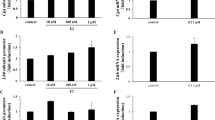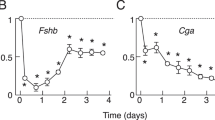Abstract
Introduction
Polycystic ovary syndrome (PCOS) is associated with insulin resistance and hyperinsulinemia, which might contribute to the hypersecretion of luteinizing hormone (LH). Hyperprolactinemia is another finding in a subgroup of patients with PCOS, whereas its relation to hyperinsulinemia is not fully understood yet.
Methods
In the present study we tested the hypothesis that insulin might affect LH or prolactin secretion of cultured female rat pituitary cells. To address the mechanisms by which insulin could act at the intracellular level we examined the GnRH- and TRH-induced Ca2+ signals in single gonadotrophs and lactotrophs, because Ca2+ is an important component of GnRH signal transduction that is closely related to exocytosis.
Results
Cells treated for 24 h with insulin (10−9 M) showed an enhancement of basal and agonist-induced LH and prolactin secretion. Insulin did not affect GnRH- and TRH-induced Ca2+ signals compared to controls. There were no differences neither in the frequency nor in the amplitude of the Ca signal.
Conclusion
Our findings suggest that insulin might contribute to LH hypersecretion. Insulin might be partially responsible for hyperprolactinemia. Since insulin did not affect Ca signaling, other components of the GnRH signal transduction pathway might be involved in LH hypersecretion.





Similar content being viewed by others
References
Abdel-Gadir A, Khatim MS, Mowafi RS et al (1992) Implications of ultrasonically diagnosed polycystic ovaries. II. Studies of dynamic and pulsatile hormonal patterns. Hum Reprod 7:458–461
Adashi EY, Hsueh AJ, Yen SS (1981) Insulin enhancement of luteinizing hormone and follicle-stimulating hormone release by cultured pituitary cells. Endocrinology 108:1441–1449
Balen AH (1993) Hypersecretion of luteinizing hormone and the polycystic ovary syndrome. Hum Reprod 8 [Suppl 2]:123–128
Belisle S, Menard J (1980) Adrenal androgen production in hyperprolactinemic states. Fertil Steril 33:396–400
Bracero N, Zacur HA (2001) Polycystic ovary syndrome and hyperprolactinemia. Obstet Gynecol Clin North Am 28:77–84
Brann DW, Mashesh VB (1991) Regulation of gonadotropin secretion by steroid hormones. Front Neuroendocr 12:165–70
Clapp DH, Wiebe RH (1983) The effect of hyperprolactinemia on the diurnal variation of adrenal androgens. Fertil Steril 39:749–752
Dunaif A, Scott D, Finegood D et al (1996) The insulin-sensitizing agent troglitazone improves metabolic and reproductive abnormalities in the polycystic ovary syndrome. J Clin Endocrinol Metab 81:3299–3306
Ehrmann DA, Barnes RB, Rosenfield RL (1995) Polycystic ovary syndrome as a form of functional ovarian hyperandrogenism due to dysregulation of androgen secretion. Endocr Rev 16:322–353
Ehrmann DA, Schneider DJ, Sobel BE et al (1997) Troglitazone improves defects in insulin action, insulin secretion, ovarian steroidogenesis, and fibrinolysis in women with polycystic ovary syndrome. J Clin Endocrinol Metab 82:2108–2116
Franks S (1995) Polycystic ovary syndrome. N Engl J Med 333:853–861
Fulghesu AM, Lanzone A, Andreani CL et al (1995) Effectiveness of a somatostatin analogue in lowering luteinizing hormone and insulin-stimulated secretion in hyperinsulinemic women with polycystic ovary disease. Fertil Steril 64:703–708
Higuchi K, Nawata H, Maki T et al (1984) Prolactin has a direct effect on adrenal androgen secretion. J Clin Endocrinol Metab 59:714–718
Iuorno MJ, Nestler JE (2001) Insulin-lowering drugs in polycystic ovary syndrome. Obstet Gynecol Clin North Am 28:153–164
Kawaguchi M, Funabashi T, Kimura F (1998) Insulin-induced hypoglycemia does not impair the surge of luteinizing hormone secretion in the proestrus rat. Neurosci Lett 256:131–134
Nestler JE (1997) Role of hyperinsulinemia in the pathogenesis of the polycystic ovary syndrome, and its clinical implications. Semin Reprod Endocrinol 15:111–122
Nestler JE, Jakubowicz DJ (1996) Decreases in ovarian cytochrome P450c17α activity and serum free testosterone after reduction of insulin secretion in polycystic ovary syndrome. N Engl J Med 335:617–623
Ortmann O, Merelli F, Stojilkovic SS, Schulz KD, Emons G, Catt KJ (1994) Modulation of calcium signaling and LH secretion by progesterone in pituitary gonadotrophs and clonal pituitary cells. J Steroid Biochem Mol Biol 48:47–54
Ortmann O, Bakhit M, Bloh P et al (1995) Ovarian steroids modulate gonadotropin-releasing hormone-induced biphasic luteinizing hormone secretory responses and inositol phosphate accumulation in rat anterior pituitary cells and alpha T3–1 gonadotrophs. J Steroid Biochem Mol Biol 54:101–109
Ortmann O, Tomic M, Weiss JM et al (1998) Dual action of androgen on calcium signaling and luteinizing hormone secretion in pituitary gonadotrophs. Cell Calcium 24:223–231
Pugeat M, Ducluzeau PH (1999) Insulin resistance, polycystic ovary syndrome and metformin. Drugs 58:41–46
Soldani R, Cagnacci A, Yen SS (1994) Insulin, insulin-like growth factor I (IGF-I) and IGF-II enhance basal and gonadotrophin-releasing hormone-stimulated luteinizing hormone release from rat anterior pituitary cells in vitro. Eur J Endocrinol 131:641–645
Soldani R, Cagnacci A, Paletti AM et al (1995) Modulation of anterior pituitary luteinizing hormone response to gonadotropin-releasing hormone by insulin-like growth factor I in vitro. Fertil Steril 64:634–637
Stojilkovic SS, Catt KJ (1995) Expression and signal transduction pathways of gonadotropin-releasing hormone receptors. Recent Prog Horm Res 50:161–205
Stojilkovic SS, Stutzin A, Izumi SI et al (1990) Generation and amplification of the cytosolic calcium signal during secretory responses to gonadotropin-releasing hormone. New Biol 2:272–283
Thomas AP, Bird GS, Hajnoczky G, Robb-Gaspers LD, Putney JW Jr (1996) Spatial and temporal aspects of cellular calcium signaling. FASEB J 13:1505–1517
Tse A, Tse FW, Hille B, Horstmann H, Almers W (1997) Local Ca2+ release from internal stores controls exocytosis in pituitary gonadotrophs. Neuron 18:121–132
Velazquez E, Acosta A, Mendoza SG (1997) Menstrual cyclicity after metformin therapy in polycystic ovary syndrome. Obstet Gynecol 90:392–395
Willis D, Franks S (1996) Insulin action in human granulosa cells from normal and polycystic ovaries is mediated by the insulin receptor and not the type-I insulin-like growth factor receptor. J Clin Endocrinol Metab 80: 3788–3790
Xia YX, Weiss JM, Polack S, Diedrich K, Ortmann O (2000) Interactions of insulin-like growth factor I, insulin, and estradiol on GnRH-stimulated luteinizing hormone release from female rat gonadotrophs. Eur J Endocrinol 144:73–79
Acknowledgments
We are very grateful to Dr. S.S. Stojilkovic, SCS ERRB NICHD National Institutes of Health, for calcium measurements. This study was supported by a grant from the Medical University of Lübeck. We are grateful to the National Hormone and Pituitary Agency and A.F. Parlow for providing LH and prolactin RIA reagents.
Author information
Authors and Affiliations
Rights and permissions
About this article
Cite this article
Weiss, J.M., Polack, S., Diedrich, K. et al. Effects of insulin on luteinizing hormone and prolactin secretion and calcium signaling in female rat pituitary cells. Arch Gynecol Obstet 269, 45–50 (2003). https://doi.org/10.1007/s00404-003-0506-9
Received:
Accepted:
Published:
Issue Date:
DOI: https://doi.org/10.1007/s00404-003-0506-9




